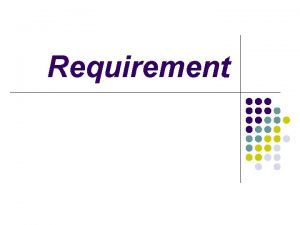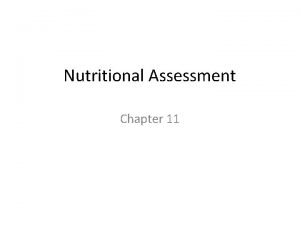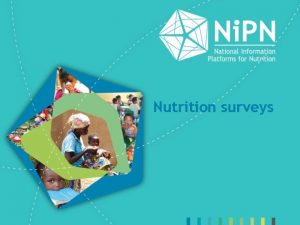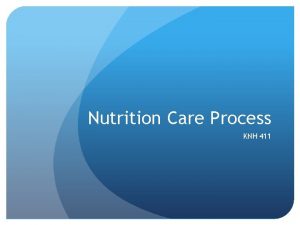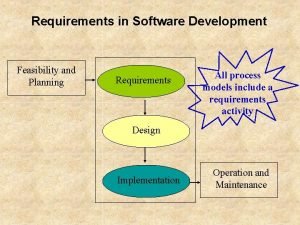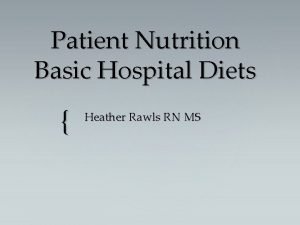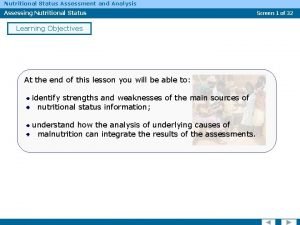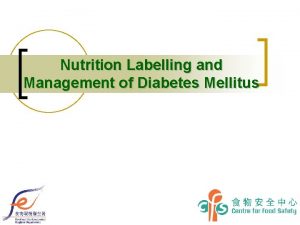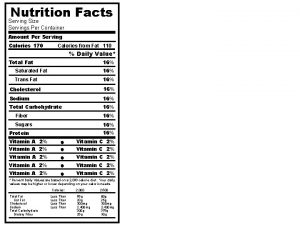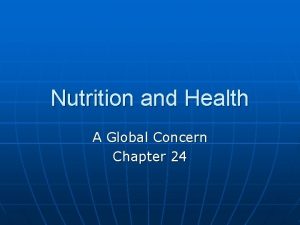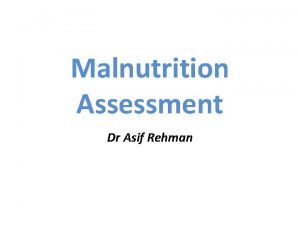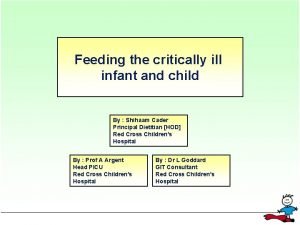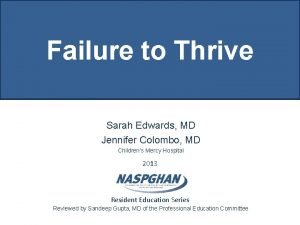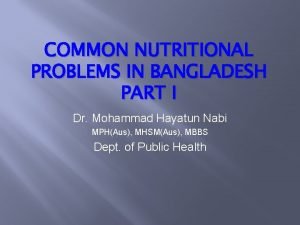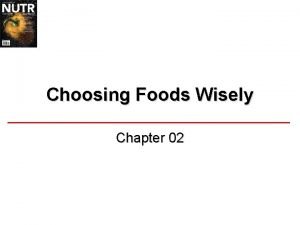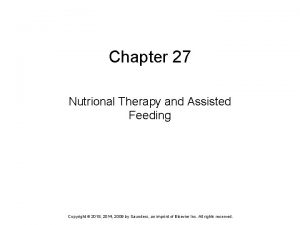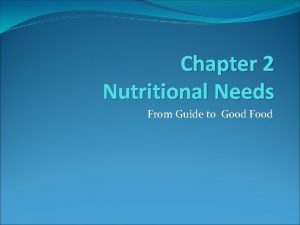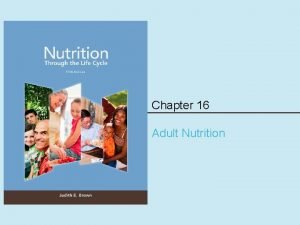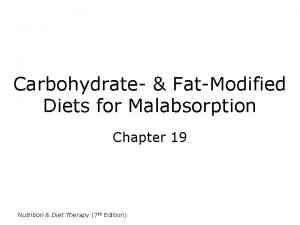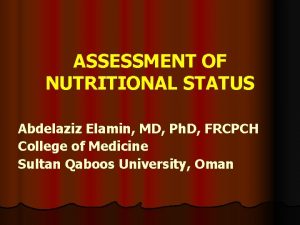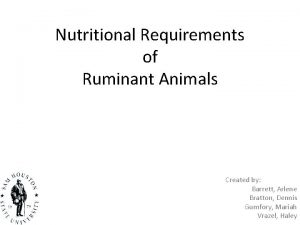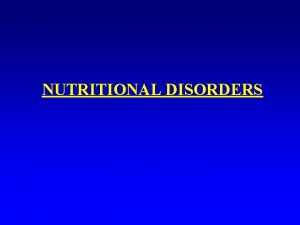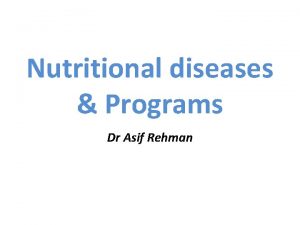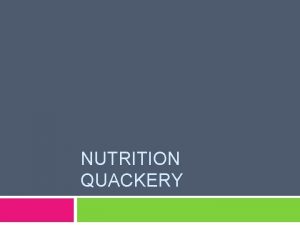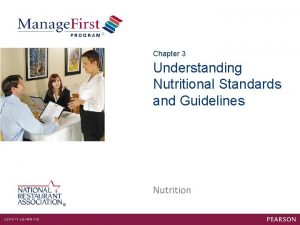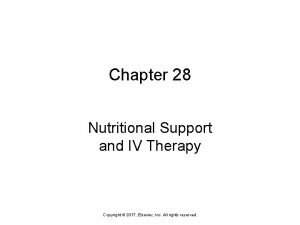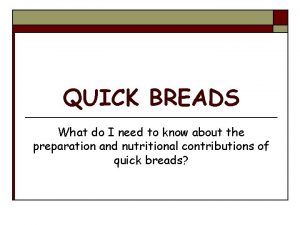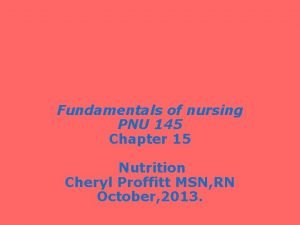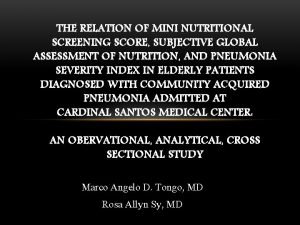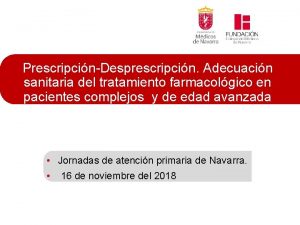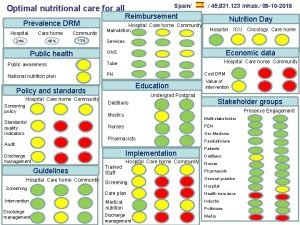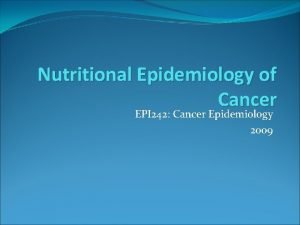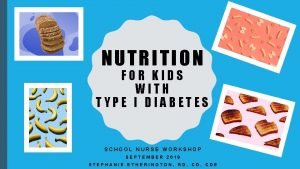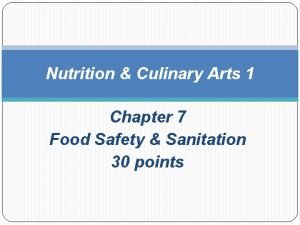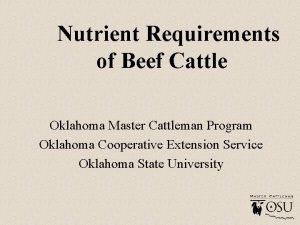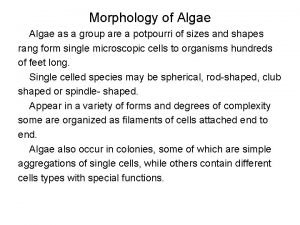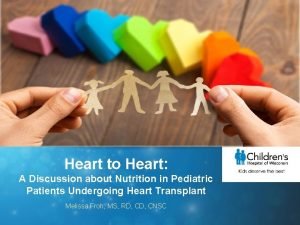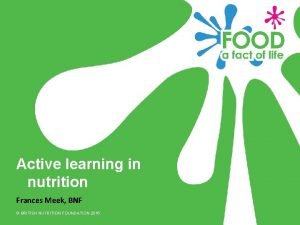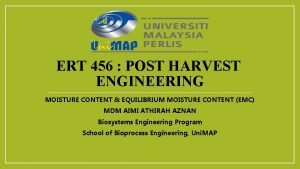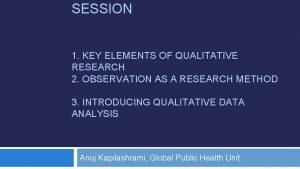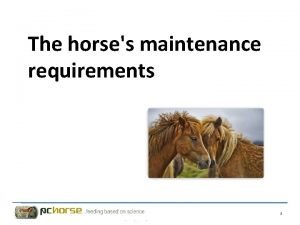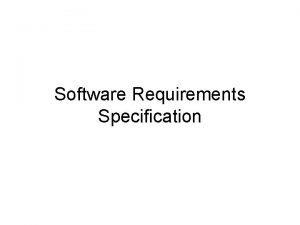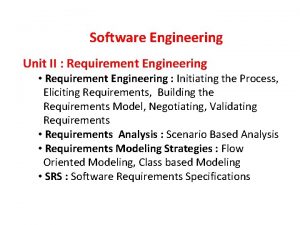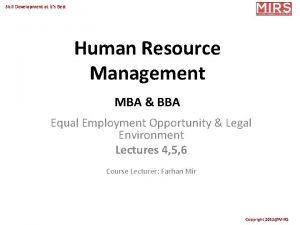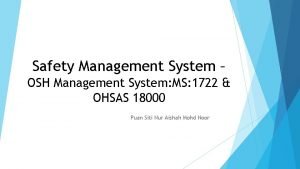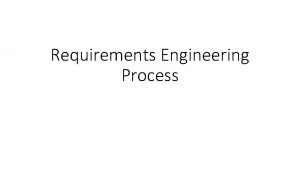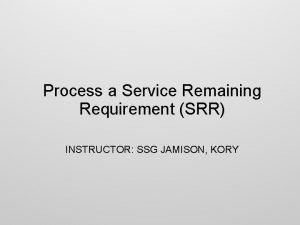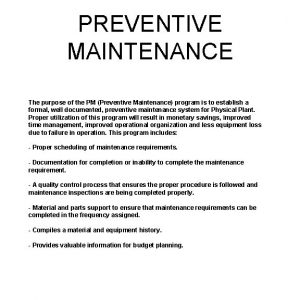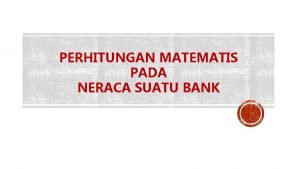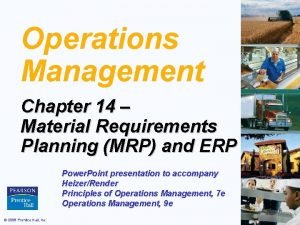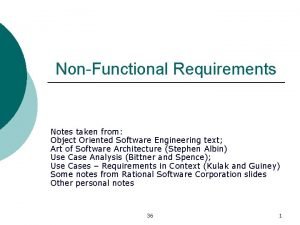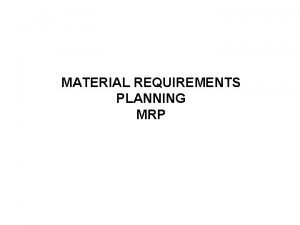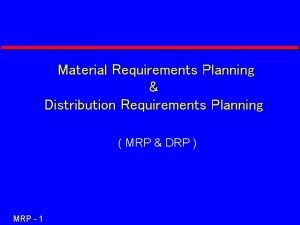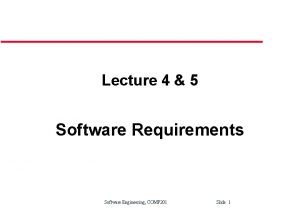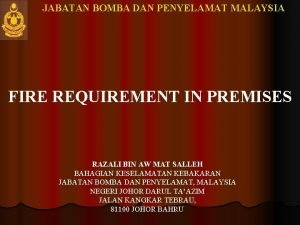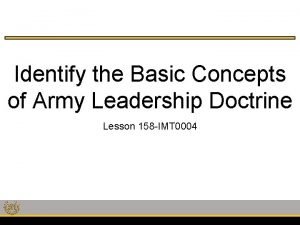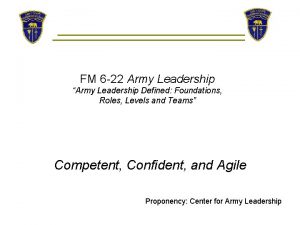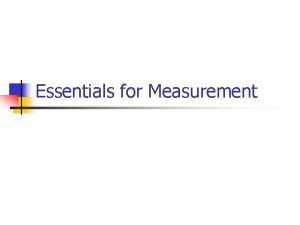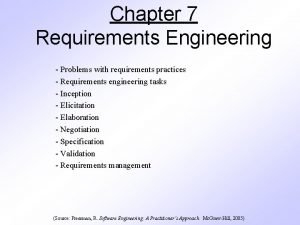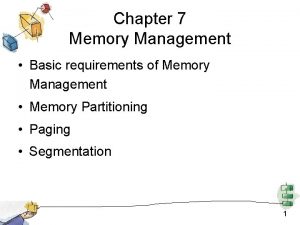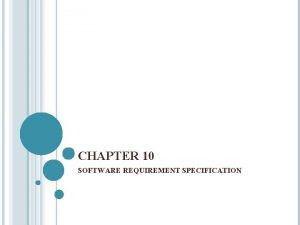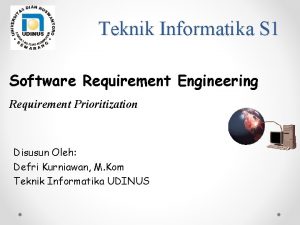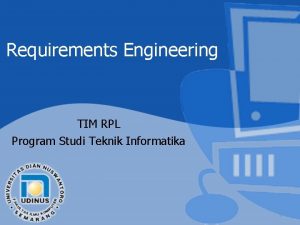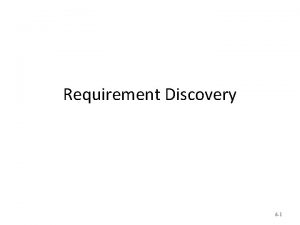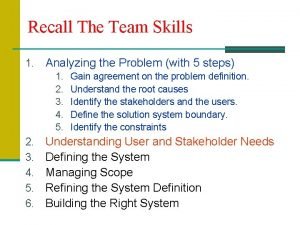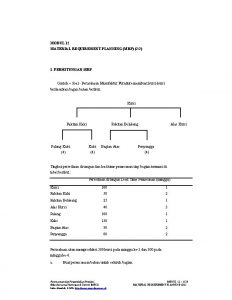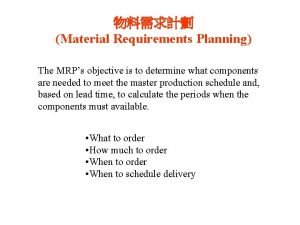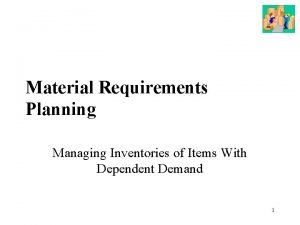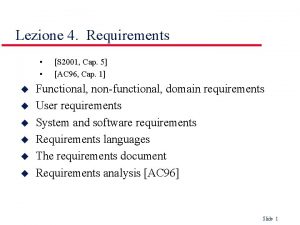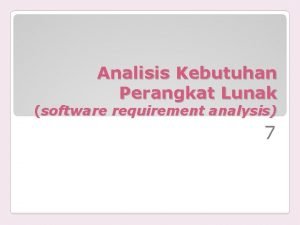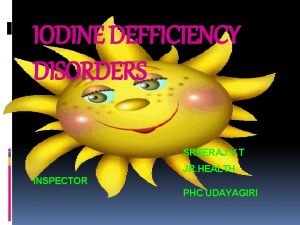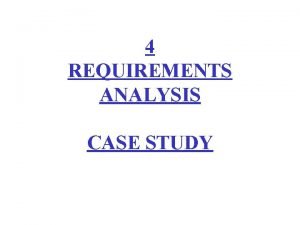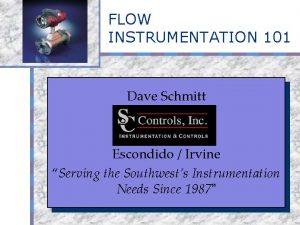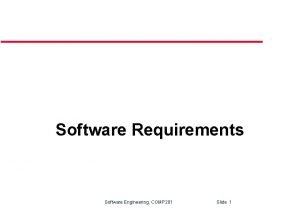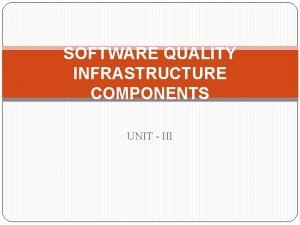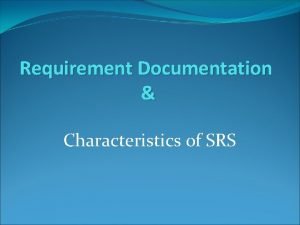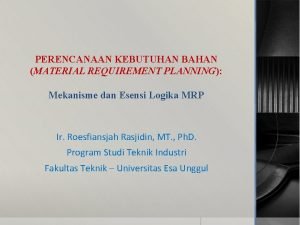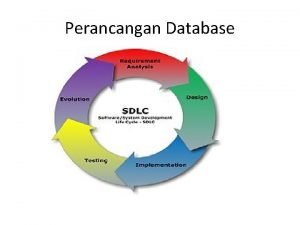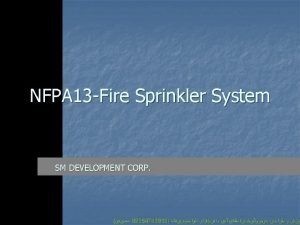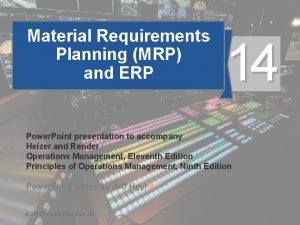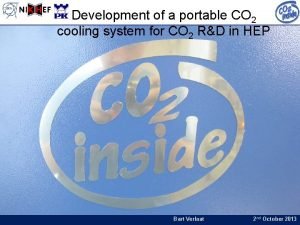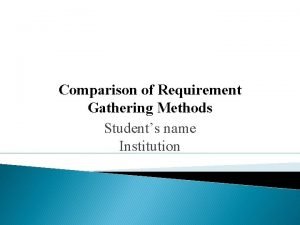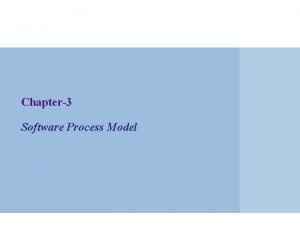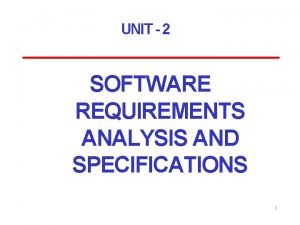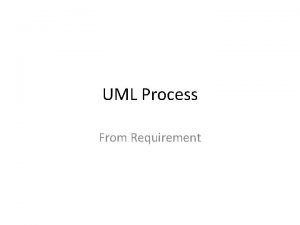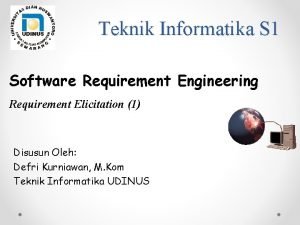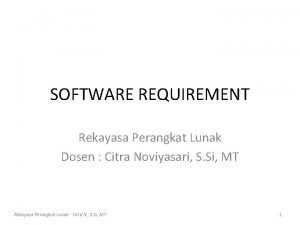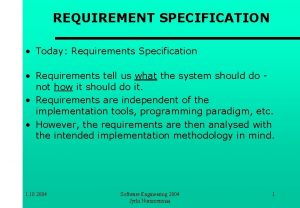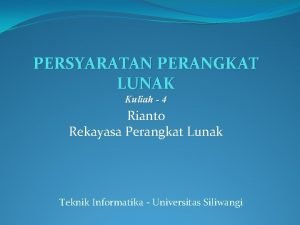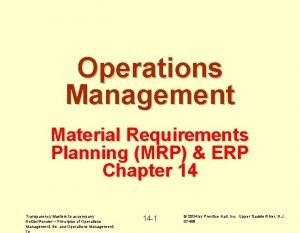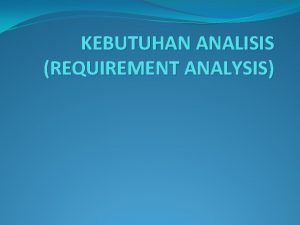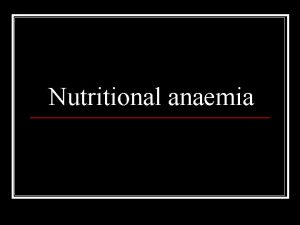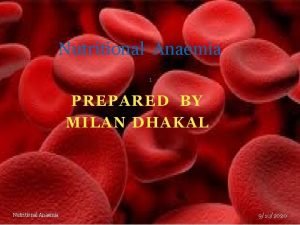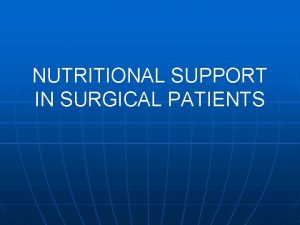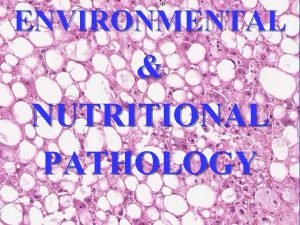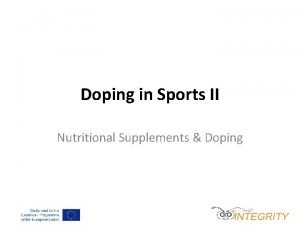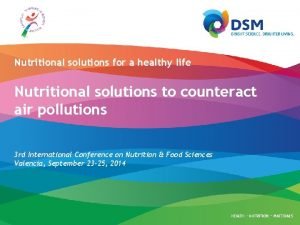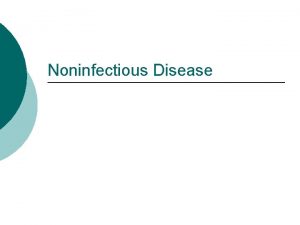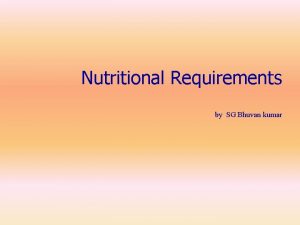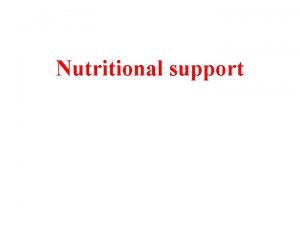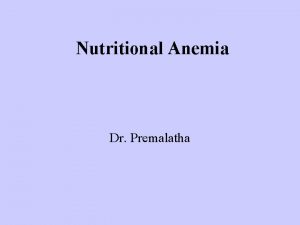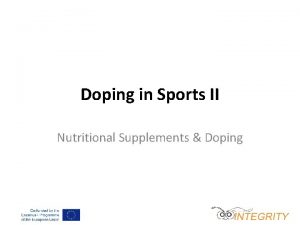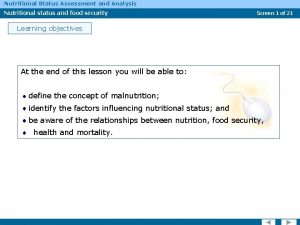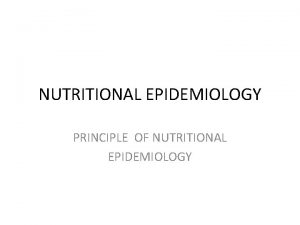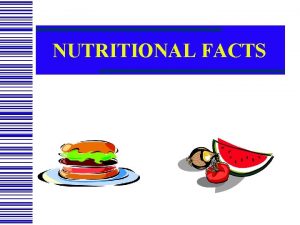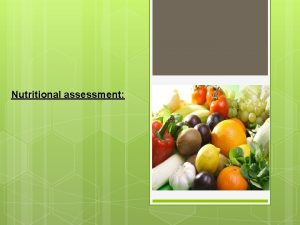Nutritional Requirement Content Definition of nutritional requirement Importance














































































































































































- Slides: 174

Nutritional Requirement Content ◦ Definition of nutritional requirement ◦ Importance of knowing nutritional requirement ◦ Dietary reference intakes ◦ Nutrient requirement at critical stages ◦ Factors affecting nutritional requirement 1

Learning objectives: At the end of the session students are expected to: - Rationale of knowing nutritional requirements - Describe the principle behind estimation of nutritional requirement - Know the different factors that affect 2

Introduction What is nutritional requirement? A nutritional requirement is defined as the lowest continuing intake level of a nutrient that, for a specified indicator of adequacy, will maintain a defined level of nutriture in an individual. Nutriture- bodily condition with respect to nutrition and especially with respect to a given nutrient. 3

Why do we know nutritional requirements? Determining food and nutrition adequacy of population food intakes Determining nutrient needs, and evaluating and ensuring the adequacy of ration quality and quantity for vulnerable groups (refugees, in times of conflict or famine ). Providing information to manufacturers of infant formula and processed complementary foods 4

Dietary reference intakes (values) 5

Estimated average requirement (EAR) �It is the average daily nutrient intake level that meets the needs of 50% of the “healthy” individuals in a particular age and gender group. � 50% of subjects would not have their needs met. 6

Reference Nutrient intake ( RNI) or Recommended Dietary Allowance (RDA) �The daily amount of a nutrient considered adequate to meet the known nutrient needs almost all (97. 5 percent) apparently healthy individuals in an age and sex-specific population group. Note: Recommendations are set high enough above the estimated average requirement to meet the needs of most healthy people � 7

Lower Reference Nutrient Intake (LRNI) �The minimum amount of a nutrient that is enough for only the small number of people who have low requirements (2. 5%) �The majority of the population need more 8

Adequate intake ( Safe intake) �The average daily amount of a nutrient that appears sufficient to maintain a specified criterion. �. These values are based on observed or experimentally determined estimates of nutrient intake by a group (s) of healthy individuals. �At this level there is no risk of deficiency and is below the level where there is a risk of undesirable effects. 9

Upper tolerable nutrient intake level �The maximum daily amount of a nutrient that appears safe for most healthy people and beyond which there is an increased risk of adverse health effects. Note: UTNI serves as a reminder to keep nutrient intakes below amounts that increase the risk of toxicity 10

What is energy requirement? �“…is the amount of food energy needed to balance energy expenditure in order to maintain body size, body composition and a level of necessary and desirable physical activity consistent with long-term good health. �This includes the energy needed for the optimal growth and development of children, for the deposition of tissues during pregnancy, and for the secretion of milk during lactation consistent with the good health of mother and child. ” WHO, FAO, 11

Energy requirement. . . �Energy requirements are also based on the following factors: 1. Basal metabolism - Need to maintain vital functions - Depends on age, sex, body composition , etc 2. Metabolic response to food - Needed for digestion , transport and metabolism of nutrients 3. Physical activity - all daily activities ranging from work to play to rest. These activities may be occupational, associated with work, or discretionary, associated with household 12 and

Energy requirement. . . 4. Growth - For forming new tissues , and energy deposited in those tissues. 5. Pregnancy - Production of fetal and maternal tissues 6. Lactation - For milk production( secretion) and energy stored in the milk 13

Nutritional Requirement during critical periods Contents Nutrient requirement during: – Pregnancy – Lactation – Infancy – Old age 14

Nutrient requirement during pregnancy �Women’s nutrient requirement substantially increase during pregnancy. �When energy and other nutrient intake do not increase, the body’s own reserves are used, leaving a pregnant women weakened. �Pregnant women also require more protein, iron, iodine, vitamin A, folate and other nutrients. Deficiencies of certain nutrients are associated with maternal complication and death, fetal and newborn death, birth defect, decrease physical and mental potential of the child. 15

Energy requirement during pregnancy – 300 kcal/day extra amount of energy is required (14% more than non pregnant non lactating). Protein Needed for the development of new material tissue as the placenta and the expansion of the uterus, breasts, and blood volume as well as the development of fetal tissue. – 10 g/day more than RDA is need 16

Energy requirement during pregnancy – 300 kcal/day extra amount of energy is required (14% more than non pregnant non lactating). Protein Needed for the development of new material tissue as the placenta and the expansion of the uterus, breasts, and blood volume as well as the development of fetal tissue. – 10 g/day more than RDA is need 17

Vitamins and Minerals 18

19

Energy demands of Lactation ◦ Much greater than that of pregnancy. ◦ Attributable to rapid growth of infants. ◦ Some of the energy is derived from maternal stores during pregnancy. ◦ 23% increase in energy demand over a nonpregnant , non lactating woman. 20

Macro-nutrient need during lactation �Carbohydrate-RDA - 210 g/day ( Extra 550 -840 kcal. �Protein– RDA- 71 g/day (extra 284 Kcal) �Lipid-RDA- 30 g/day 21

22

Infancy �Is a period from birth to the completion of first year. – Characterized by the most rapid growth in human life. – Length increases by about 40% and weight is tripled. – Head circumference is also increased by about 30%. 23

Energy foods and energy nutrients – A new born requires about 90 -120 kcal/kg BW versus an adult requirement of 30 -40 kcal/kg BW for maintenance. – Most of the energy is required for BMR followed by for growth. 24

Protein – Still the highest period in human life in terms of protein requirement. – 1. 98 g/kg of BW is required for proper growth to occur. – RDA for infants is 2. 2 g/kg for the first 6 months and then reduced to 2 g/kg in the second 6 months. 25

Fat and fatty acids - More than half of the energy in BM is derived from fat. - Essential fatty acids are required in larger amount during infancy (>30% of the total energy). Mainly for neurological development. Milk is a better source of both omega-3 and 6 PUFAs. 26

Vitamins and Minerals �Consumption of 700 -800 ml of BM provides twice RDA of Vitamin A but same intake will not allow the acquisition of RDA of Vitamin D. � BM is not also a good source of Vitamin K , it is recommended to be given routinely at birth. �If the mother was taking enough Fe during pregnancy , the iron store in the infant is enough for the first 6 months of life. �Fe supplementation is needed after 6 months of life. 27

Old age � An elderly person requires less energy than a younger individual due to reductions in muscle mass and physical activity. � Some daily nutrients requirements for elderly people differ from those of younger adults. For example, in order to reduce the risk for age related bone loss and fracture, the requirement for vitamin D is increased from 200 IU/day to 400 IU/day in individuals of 51 -70 years of age and to 600 IU/day for those over 70 years of age. 28

Cont’…. �However, iron requirement reduced from 18 mg/day to 8 mg in elderly women due to better iron conservation and decreased losses in postmenopausal women compared with younger women. �Some elderly people have difficulty in achieving adequate nutrition because of age or disease related impairments in chewing, swallowing, digesting and absorbing nutrients. 29

cont’…. . Therefore, for older people, as with younger adults, , the diet should follow the principles of a healthy balanced diet ( food guide). Bread and other cereals and potatoes Fruit and vegetables Milk and dairy products Meat, fish, and alternatives Foods containing fat and sugar § 30

Nutritional Assessment Learning Objectives ØAt the end of this session you should be able to: o Define nutritional assessment. o Identify methods of nutritional assessment. o Describe the advantages and disadvantages of each nutritional assessment method. 31

Introduction What is nutritional assessment? § Nutritional assessment is an interpretation of anthropometric, biochemical (laboratory), clinical and dietary survey data to tell whether a person/ group of people is well nourished or malnourished (Over nourished or under nourished). § There are two methods of assessing Nutritional status: 1. Direct method 2. Indirect method 32

Indirect methods - include assessment of indicators of the food and nutrition situations in the area/ region of interest by looking at certain data that are closely related to malnutrition or which are aggravated by malnutrition. - These include: - Cause specific mortality rates - Age specific mortality rates - Meteorological data (rainfall data ) - Production pattern and distribution pattern - Market price of foods 33

Direct methods �Involve the direct measurement of body dimensions and proportions, determination of tissue or body fluid concentrations of nutrients, dietary intake, appearance of the clinical symptoms and signs. �They abbreviated as the ABCDs Ø A=Anthropometry Ø B= Biochemical/Biophysical, Ø C= Clinical, Ø D= Dietary 34

A. Anthropometric assessments �Anthropometry comes from two words: - Anthropo = Human, and - Metry = measurement. �Definition: - Anthropometry refers to measurement of variations of physical dimension and gross composition of human body at different levels and degrees of nutrition (Jelliff, 1966). 35

Cont’… �Anthropometric measurements could be used both in the clinical and field set-ups. �In the clinical set-ups they are used to assess the nutritional status of: – severely malnourished patient to assess the impact of nutritional intervention. 36

Purposes of Anthropometric measurements �Anthropometric measurements are performed with two major purposes in mind: IN CHILDREN: to assess physical growth IN ADULTS: to assess changes in body composition or weight. �The following body measurements are good indicators of growth performance of children at different ages when combined with the cut-off points. 37

Anthropometric measurements of growth 1. Head circumference (HC) �Measured using flexible measuring tape around 0. 6 cm wide to the nearest 1 mm. �It is the circumference of the head along the supra orbital ridge anteriorly and occipital prominence posteriorly. �HC is useful in assessing chronic nutritional problems in under two children. �But after 2 years as the growth of the brain is sluggish it is not useful. 38

2. Length o A wooden measuring board (also called sliding board) is used for measuring length. o It is measured in recumbent position in children <2 yrs old to the nearest 1 mm. o It is always > height by 1 -2 cm. o An assistance of two people is needed in taking the measurement. 39

40

3. Height Is measured in children > 2 yrs and adults in standing position to the nearest 0. 1 cm. The head should be in the Frankfurt plane during measurement, knees should be straight and the heels, buttocks and the shoulders blades, should touch the vertical surface of the stadiometer (anthropometer) or wall. Stadiometer or portable anthropometer can be used for measuring. There is also a plastic instrument called acustat Stadiometer that is cheaper than the conventional Stadiometer. 41

42

4. Weight Most accurate and sensitive method of measuring growth is weight gain. �Suspended scale & weighing sling is used for measurement of weight in children < 2 years. • In adults and children >2 years, beam balance is used. • 43

44

Indices derived from these measurements Ø What is an index? It is a combination of two measurements or a measurement plus age. Ø The following are few of them: - Head circumference-for age - Weight -for-age - Height-for age - Weight for height 45

Meanings of the indices derived from growth measurements 46

q Both weight for age and weight for height are indices sensitive to acute changes to nutritional status. q Height for age of children in a given population indicates their nutritional status in the long run. 47

Indicator �An indicator is an index + a cut-off point. E. g. - W F A < 60% = is indicator of severe malnutrition - BMI < 16 kg/m 2 = indicator of severe chronic energy deficiency - W F H < 7 o% = is indicator of severe wasting 48

Assessment of body composition q Linear growth ceases at around the age of 2530 years. q Therefore, the main purpose of nutritional assessment of adults using anthropometry is determination of the changes of body weight and body composition. 49

Assessment of body composition using anthropometry In assessing body composition we consider the body to made up of two compartments: q The fat mass and the fat free mass. Total body mass= Fat mass + fat free Mass. q q. Therefore different measurements are 50

Measurements used for assessing fat free mass: q Mid upper arm circumference*** q Mid thigh circumference q Mid calf circumference 51

1. Mid upper arm circumference(MUAC) �Is used for screening purposes especially in emergency situations where there shortage of human resource, time and other resources as it is less sensitive as compared to the other indices. �It is measured half way between the olecranon process and acromion process using non stretchable tap. �In children the cut-off points are: - Normal >12. 5 cm - Mild to moderate malnutrition 11. 5 -12. 5 cm - Severe malnutrition <11. 5 cm 52

MUAC… �It is a sensitive indicator of risk of mortality. �Useful for screening of children for community based nutrition interventions. �Useful for the assessment of nutritional status of pregnant and lactating women. 53

54

55

Measurements used to assess fat mass: q. Body q mass index Waist to Hip circumference ratio q. Skin fold thickness 56

1. Body mass Index(BMI) �Body mass index the best method for assessing adult nutritional status as the index is relatively independent the height of the person. �Therefore, it is most frequently used for assessing adult nutritional status. 57

Cut-off points for BMI • • > 40 kg/m 2 = very obese 30 -40 kg/m 2 = obese 26 -30 kg/m 2 = overweight 18. 5 -25 kg/m 2 = Normal 17 -17. 9 kg/m 2 = mild chronic energy deficiency 16 -16. 9 kg/m 2 = Moderate chronic energy deficiency < 16 kg/m 2 = severe chronic energy deficiency 58

This classification is based on the mortalities and morbidities associated with either extremities 59

2. Skin fold thicknesses Provides an estimate of the size of subcutaneous fat depot �Assumptions: � ◦ Thickness to the subcutaneous adipose tissue reflects a constant proportion of the total body fat ◦ The selected skin fold sites are representative �Selected sites : ◦ Biceps and Triceps ( mid point of the arm), ◦ Sub-scapular ( left arm and shoulder relaxed ) �Best measured by precision skin fold thickness calipers 60

Cont’… �which have a constant and defined pressure of 10 g/sq. mm through out the range of measured skin folds. Measurements are made in triplicate until readings agree within ± 1. 0 mm �All the measurements should be made on the left side � 61

Measuring Skinfold Fat Thickness at the Triceps Skinfold Site 62

3. Waist to hip circumference ratio q It is the circumference of the waist measured mid-way between the lowest rib cage and anterior superior iliac spine divided by the circumference of the hip measured at the level of the greater trochantor off the femur( both are measured to the nearest 0. 5 cm) q If the ratio is > 1 in male, and > 0. 87 in female there is high risk of coronary heart disease. 63

Waist-to-hip ratio (WHR) 64

Expressing anthropometric measurements � 65

Class activity �If a 6 years old child has: - • Weight 13. 3 , height 107. 5 and � median values are: - • H/A = 118. 5 • W/A = 21. 6 • W/H = 17. 6 and standard deviation are 4. 9, 3. 2, 1. 6 respectively. �Calculate a. HFA Z score b. WFH Z score c. WFA Z score 66

2. Percentage of the Median § The median is the value at exactly the midpoint b/n the largest & smallest. § If a child’s measurement is exactly the same as the median of the reference population we say that they are “ 100% of the median” 67

Cut off points for acute malnutrition (weight for height) Acute malnutrition based on weight-for-Height in z-scores and percentage of the median 68

Cut off points for chronic malnutrition (height for age) � Chronic malnutrition based on Height-for-Age in z- scores and percentage of the median 69

Cut off points for Underweight � Underweight based on Weight-for-Age in z-scores and percentage of the median. 70

3. Percentiles � The percentile is the rank position of an individual on a given reference distribution arranged in order of magnitude � Percentiles are stated in terms of what percentage of the group the individual equals or exceeds � E. g. , the child's height-for-age being at the 80 th percentile means that 80% of children of his age in the reference population have a height lower than him � If a boy’s height is 141. 8 cm and he is at the 10 th percentile, it means 10 percent of boys have a height below 141. 8 cm 71

Quality control measures in anthropometric surveys The following issues need to be considered in carrying out anthropometric surveys to ensure the quality of data: q. Calibration of the instrument after each measurement and after moving the instrument from one room to another. q. Standardization q of procedures Verification of at least 10 % of the data by the main investigator. 72

Cont’… q. Training of the data collectors and limiting the coefficient of variation to be less than 3%(CV = standard / mean X 100) q. Use one rather than multiple observer for the same subject over time. q. Mark anatomic sites of measurement with indelible ink when repeatedly measuring the same subject over a short time span. 73

Advantages and disadvantages of Anthropometric measurements 74

B. Biochemical(laboratory) methods �This involves measurement of the amount of nutrient in a particular storage site in the body fluids (blood, urine, saliva) and tissues (hair and nail). �For example, serum retinol levels to assess vitamin A status. This is generally expensive, time consuming, need highly well trained personnel and sophisticated instrument 75

C. Clinical methods �This are detection of deviations from the normal state of nutrition just by observing and interpreting clinical signs and symptoms of deficiency or under intake, for instance, see the following. 76

Cont’… Advantages – Fast & Easy to perform – Inexpensive – Non-invasive Limitations – Did not detect early cases – Trained staff needed 77

D. Dietary methods 78

Methods used to assess current intake (at a group or individual level) I. Weighed record method: In this method the subject will be asked to weigh whatever he/she consumes including drinks both before cooking and after cooking and the portion sizes he consumed and the left over. Advantages: o It is more accurate o There is no respondent memory loss Disadvantages High respondent burden Change of the dietary habit during the survey due fear of burden Needs literate and numerate respondents Costly 79

Cont’… 2. Observed weighed method q In this method the investigator him/herself records the amount and type of food consumed by the study subjects over specified period of time. q This method is usually applied for disabled people, infants and small children, mentally ill people or institutionalized elderly people or patients admitted to a hospital. Advantage VS disadvantages q The same as the observed weighed 80

Cont’… 3. Food Diary method �In this method the subject/s are asked to record what ever they eat including beverages for specified period of time with estimation of the portion sizes consumed. �Advantage ◦ May give relatively accurate estimate of the nutrient intake if done properly. �Disadvantage ◦ High respondent burden ◦ Literacy and numeracy of subjects needed ◦ High coding burden 81

Methods Used to assess past intake 1. 24 hours dietary recall In this method, the subjects are requested to remember whatever they consumed within the last 24 hours. �This involves all beverages, snacks deserts etc. That have been ingested from x time yesterday to x time today. �The portion sizes consumed during this time should also be determined by the respondents by assessing them to use either photographs or the common food being consumed at different sizes or by using a line graph etc. � 82

Advantages and disadvantages of 24 hrs dietary recall method Advantages Disadvantages q Relatively �A cheap Quick q Less respondent burden q No chance for the respondents to change their dietary habit q The usual intake of a group can be determined from a single 24 hrs recall q single day 24 hrs recall does not indicate the usual intake of individuals � Respondent memory laps � Social desirability bias (the flat slop syndrome) � Has less precision � Accuracy depends on the respondent’s ability to estimate portion sizes 83

Reasons why a single day assessment does not give the true mean intake �Day of the week effect �Seasonal effects �Consecutive �Random �Holiday /nonconsecutive days within person variance effects(feasts and fasts) 84

2. Dietary history �This method is used to assess the nutrient intake of an individual or a group from food over a longer period of time, usually to see the association between diet and disease. Advantages Disadvantages q It gives the dietary habits of an individual or a group of people over a longer periods of time q Less respondent burden is very difficult to validate q It needs a very highly trained interviewer q It gives just a relative if not an absolute information 85

3. Food frequency questionnaire • This method is based on the preparation of a food frequency questionnaire, which is based on the local staple diet to determine the frequency of consumption of a particular nutrient. • This could be achieved through self or interviewer administration of the questionnaire. • Sometimes the quantities consumed could be included, in such circumstances, the FFQ is called semi quantitative FFQ. • The following table indicates the frame of a food frequency questionnaire. 86

Example of semi quantitative FFQ for Vitamin A friendly foods 87

Advantages and Disadvantages of FFQ Advantages Disadvantages � It q It is usually used for areas where there is a geographically widely scattered study population � It is less costly especially if self administered � Less respondent burden is very difficult to develop especially in multi-cultural society where different staple foods are consumed q It needs literate and numerate subjects 88

Thank you 89

Food safety and quality § Food borne diseases § Methods of food preservation § Food additives and preservatives & health implications

Introduction v Food safety: refers to free from all those hazards, whether chronic or acute, that make food injurious to the health of the consumer. v Area of food safety: Food hygiene Pest control Waste management Cleaniing and sanitizing

Con’t…. v Food quality is defined as feature and characteristics that influence product’s value to consumers such as: appearance(size, color, shape and consistency) Texture Flavor(odour and taste), adulteration Correct labelling with the ingredients, nutritional information, Packaging,

Food control is defined as: va mandatory regulatory activity of enforcement by national or local authorities § to provide consumer protection and § ensure that all foods during production, handling, storage, processing, and distribution are �safe, wholesome and fit for human consumption; �conform to safety and quality requirements; and are honestly and accurately labelled as prescribed by law.

con’t…. � Effective national food control systems are essential to protect the health and safety of domestic consumers. � Responsibility for food control in most countries is shared between different agencies or ministries. � For instance; FAO and WHO have a strong interest in promoting national food control systems. � This is particularly important for developing countries as they seek to achieve improved food safety, quality and nutrition.

The principal objectives of national food control systems are: � Protecting public health by reducing the risk of foodborne illness; � Protecting consumers from unsanitary, unwholesome, mislabelled or adulterated food; and � Contributing to economic development by maintaining consumer confidence in the food system and providing a sound regulatory foundation for domestic and international trade in food.

Food borne disease

Introduction �Although food is crucial to the maintenance of life, it can also be responsible for ill health. �In addition to the hazards posed by natural toxins, foods may also act as the vehicle for food borne diseases as microorganisms can cause spoilage of food products, (which affects food quality, and cause food poisoning).

Con’t…. � Foodborne illness (disease) occur when a person gets sick by eating food that has been contaminated with microorganism, chemical or natural toxins such as poisonous mushrooms. � The risks of food-borne diseases are becoming increasingly important; in areas where food storage and preparation safety measures are far below the optimum.

Con’t…. � In Ethiopia, the problem is high due to many reasons; like poverty and lack of public health awareness, poor water supply, poor personal hygiene and environmental sanitation, etc. � Most food-borne diseases manifest with gastrointestinal signs and symptoms characterized by diarrhea and vomiting but in the cases of botulism and listeriosis, the main symptoms are caused by effects on other ‘extraintestinal’ parts of the body.

Con’t… � More than 250 different food borne diseases have been described and most of these diseases are infections, caused by bacteria, viruses, and parasites. � Other diseases are poisonings, caused by harmful toxins or chemicals that have contaminated the food, for example, heavy metal contamination (Lead, Mercury and Arsenic). Arsenic

Classification of Food borne diseases � Depending on the mode of illness food borne diseases are classified as: �Food borne infections and �Foodborne poisonings/Intoxications. � Infections can be further categorized in to: �Invasive infection and �Non-invasive infection/ Toxicoinfections

Food borne infections �Food borne infection can be acute or chronic. �In acute infection, the onset of disease is quick and lasts only for a short duration due to a rapid immunological clearance of the microorganism. �In chronic infections, the disease is prolonged and immune clearance is not effective. 1. Invasive infection: occurs when the microorganism multiplies in food until it reaches the minimum infective dose (MID). �When the food is eaten, the microorganism acts directly on the intestine. E. g. Salmonella invade the ileum to produce watery diarrhoea.

2. Non-invasive infections / Toxicoinfections � Some bacteria cause toxicoinfection, which occurs when ingested bacteria first colonize the mucosal surface and then produce exotoxins in the intestine. � Some spread to lymph nodes, liver, spleen, brain, or other extra intestinal sites and are called systemic infection: . � Toxins can induce toxic effects on the local cells or tissues and in some cases enter blood stream and induce disease. Examples: �Cholera toxin produced by V. cholerae �Heat-labile (LT) and Heat-stable (ST) toxins produced by enterotoxigenic E. coli

Food borne intoxications These are caused by consumption of foods contaminated with: § preformed toxins of microorganisms. § Biotoxicants which are found in tissues of certain plants and animals § Poisonous substances which may be intentionally or unintentionally added to food during production, processing, transportation or storage. v Have short incubation periods(minutes to hours) and characterized by lack of fever. v

Food borne intoxications can be classified into: � Bacterial intoxication: staphylococcus, bacillus, clostridium perfringens and botulism � Fungal intoxication: aflatoxin � Chemical intoxication: heavy metals, pesticides and insecticides e. g. DDT � Plant intoxication: toxic mushroom � Poisonous animals: some toxic fishes e. g. puffer fish, tuna fish

Food preservation

�Food preservation is aimed at extending the shelf life of foods by reducing or preventing the growth of microorganisms that cause foods spoil. �We consume a lot of processed and packaged food that lies on the retail shelves for quite a long time. �To ensure that this packaged food remains edible and safe for consumption, preservatives are added to it. �These food preservatives are substances that can prevent or delay changes caused by the action of microorganisms, enzymes and/or physical agents once they are added to a given food. �Its high utilization by the food industry is due to the growing demand of chemically stable, safe and durable foods.

Methods of food preservation v Traditional methods § Cooling § Freezing § Boiling § Smoking § Sugaring § Salting v Modern industrial techniques v Pasteurization v Vacuum packing v Freeze drying v Irradiation

Food additive and health implication �Food additives are substances added to foods to maintain or improve safety, freshness, taste, texture, or appearance. �Some additive also used for sweetening and coloring. � Food additives needed to be checked for potential harmful effects on human health before they can be used. �The Joint FAO/WHO Expert Committee on Food Additives(JECFA) is the international body responsible for evaluating the safety of food additives.

Evaluating health risks of food additives and preservatives � Only food additive that have undergone a JECFA safety assessment and are found not to present an appreciable health risks to consumers, can be used. � The starting point for determining whether a food additive can be used without having harmful effects is to establish the acceptable daily intake (ADI). � ADI is an estimate of the amount of an additive in food or drinking water that can be safely consumed daily over a life time without adverse health effect.

Some food additive can cause reactions � Digestive � Nervous disorder such as diarrhea disorders- hyperactivity, irritability � Respiratory problems- asthma, rhinitis, sinusitis � Skin problems- hives. Itching, rashes, swelling Ø NB: these reactions occur when the amounts of additives in food or drinking are greater than ADI level.

Quiz-1 1. Differentiate the term food safety and food quality (2 pt)? 2. Discuss the objectives of food control system(2 pt). 3. What does mean by food borne intoxication (1 pt)?

Nutritional Surveillance Contents Food & nutrition security Definition and types of nutrition surveillance Basic steps in carrying out nutritional surveillance 113

Food & nutrition security �Food Security is defined as when “all people, at all times, have physical, social and economic access to sufficient, safe and nutritious food which meets their dietary needs and food preferences for an active and healthy life”. (FAO 2000) �A household is food secure if it can reliably gain access to food of a sufficient quality in quantities that allow all its members to enjoy a healthy and active life. 114

�Nutrition security is defined as when secure access to food is coupled with a sanitary environment, adequate health services, and the knowledge and care needed to ensure the good health of all individuals in a household. 115

Nutritional Surveillance Definition Ø It is defined as the measurement of the frequency and distribution of nutrition related diseases or problems using regularly collected and available information. Ø It comprises the compiling and analysis of nutrition information for decision making relative to national or regional polices or programme planning. 116

Methods of acquiring data in Nutritional Surveillance 1. Active surveillance: - the data are collected actively by the group /individuals running the program and hence it takes time and other resources. Information collected is timely and give more reliable data. Disadvantages – it is expensive – it requires skilled human power – it is for short period of time – it is directed towards specific disease conditions 117

2. Passive surveillance: in this type of surveillance, data are obtained from the on going programs and it does not incur too much in terms of cost, time, personnel as compared to the active surveillance, � but as information generated is to a large extent; unreliable, incomplete and inaccurate � data is not available on time � you may not get the kind of information you desire. 118

3. Sentinel site surveillance involves surveillance in a limited number of sites to detect trends in the overall well-being of the population. The sites may be specific population groups or villages that cover populations at risk. Trends are monitored for various indicators, including nutritional status, morbidity, dietary issues, coping strategies and food security. Data can be collated analyzed centrally surveillance) or (centrally-based by trained sentinel members of site the community(community based sentinel survillance 119

What are potential uses and who are the users of nutritional surveillance information? Users are: �Ministry of Agriculture � Ministry of Health �Ministry of Economic Development �Food and nutrition planning �Interministerial Coordinating Committee on Food and Nutrition 120

Types of nutritional surveillance 121

Use of nutritional surveillance information? 1. Timely warning and intervention � Nutritional surveillance was first established to warn governments of poor nations of imminent nutritional crises. It was in part modelled on health surveillance for important infectious diseases. � Certain infectious diseases such as plague and cholera are notifiable to WHO; countries require that each district or province notify the national ministry of health on a weekly basis of the number of cases of notifiable diseases. 122

Cont’… �In famines or severe crises, data on famine deaths or serious famine-related malnutrition can be collected and reported. �Unlike outbreaks of serious infectious diseases, famine brings with it many cases of serious malnutrition. �Nutritional surveillance reports on indicators that would warn a government of an approaching nutrition disaster. �As listed above, production patterns, market prices, food stocks and fall in body weights are possible indicators of food crises. 123

2. Nutrition surveillance for Policy and programme planning �Many kinds of indicators, can be used by governments or local authorities for surveillance to influence policy and programme planning. �For example, anthropometric data may be collected on a regular basis to describe PEM trends over time. �The data may be analysed to discern groups of the population most severely affected. 124

Cont’… § The next step might be to decide on direct interventions (perhaps supplementary feeding or nutrition education) for the most seriously affected groups and to suggest ways in which existing policies (for example, regarding credit for small farmers to improve agricultural productivity or subsidies for staple foods for the poor in urban areas) might be modified or strengthened to influence nutritional status. 125

3. Nutritional surveillance for management and evaluation �Surveillance can be used to evaluate programmes aimed at improving nutrition and to assist in their management. �For example, data from growth monitoring over a period of five years might be used to evaluate whether an agricultural credit scheme has improved the nutritional status of children; or § Data on IDD might be used over time to evaluate whether salt iodization activities are influencing iodine nutritional status. 126

4. Nutritional surveillance for problem identification and advocacy �Conducting surveillance for advocacy mainly involves collecting data on the prevalence of PEM or micronutrient deficiencies or on related indicators and using these data to get support for action. �Support can be solicited in different ways including making the government aware of the problems found or embarrassing the government into taking action by publicizing a serious nutrition problem in the news media. 127

Summary of use of NS 128

Nutritional surveillance cycle § The following table illustrates basic steps in nutritional surveillance. § These steps involve assessment, data collection, analysis, decision-making and the enactment of interventions based on the decisions. 129

BASIC STEPS IN NUTRITIONAL SURVEILLANCE 130

v. Nutritional intervention v. Definition- It is a corrective measure that is undertaken to reduce correct avoid the occurrence of over all malnutrition or specific nutrient deficiency or excess. v. Based on the underlying cause of the nutritional problem, the nutritional interventions can vary. 131

1. Nutrition education and promotion of horticultural activities (dietary diversification) �It promotes consumption of different varieties of foods. �Nutritional education needs to focus on the promotion of consumption of different diversities of foods. �Problems that may face this approach The food promoted must be - Culturally accepted - Consumed by the vulnerable - Target nutrients must be absorbed from 132

Cont’… - Good agricultural extension support is needed - The program must be location specific - High level of commitment needed - No immediate changes in nutritional status Advantages Long term Sustainability It is preventive High community involvement Seasonality can be offset Good in areas of chronic malnutrition 133

Cont’… Nutritional education should focus on Ø Cultural malpractices and beliefs in child feeding and weaning. Ø House hold mal-distribution of food (age, sex Ø Breast feeding and its benefits basis) Ø Hygiene- in storage, preparation, …. ) 134

2. Dietary modification § § § Aimed at modifying the energy, protein, and micronutrient content of foods especially weaning foods, and other infant formulas. e. g. – The energy and protein content of a food can be improved by fermenting or germinating adding a power flour. Other methods employed to improve the micronutrient contents of a food include. Enrichment- addition of a nutrient, which is originally present in the food, above the level found naturally. Restoration- Replacement of a nutrient lost during harvest, storage or processing. 135

Cont’… § Standardization- to compensate for the natural variation of foods grown in different geographic areas in their contents of a nutrient. § Fortification- an addition of a nutrient in a food that is not naturally present in order to enhance the consumption of the target nutrient. § Supplementation- administration of nutrients in the form of tablets, capsule, or injection. 136

3. Economic approaches A. Food-For-Work (FFW) Projects �In these projects, food is given as full or partial payment of wages to people working in land improvement or community development projects. �This strategy is very effective during food shortages, particularly when it targets the poor. �It allows able -bodied individuals to earn food rather than become reliant on food handouts. 137

Table : Advantages and Disadvantages of Food. For-Work (FFW) Projects 138

B. Food stamps �A sort of officially stamped ticket will be given to the poor which they could use for buying food from restaurant etc and this will be paid later on by the government. Advantage - They are preventive. Disadvantage They are highly targeted to urban people. They have high administrative cost. The system can be abused. 139

C. Income-Generating Projects (IGP) �Relief agencies may issue small loans and training to the most affected families in order to provide them with alternative sources of income once food aid is phased out. �These projects should have a direct impact on improving food production, e. g. , digging wells, raising poultry and small livestock, fishing or milling projects. 140

4. ENA (Essential Nutrition Actions) �Over § § § past 30 -40 years nutrition interventions were often… not integrated viewed as separate vertical programs in competition with one another not action oriented(non-specific) focused only on GM/P activities 141

ENA… �In the past 10 years growing consensus is that nutrition interventions need to be… integrated conceptually& programatically - infant & young child feeding - maternal nutrition - micronutrients based on proven impact action oriented with clear guidance « Who should take what action when » 7 action areas 142

143

144

145

146

147

148

149

150

151

152

153

154

155

ENA 3 key Program Components 1. Health facility level: integrate ENA actions into existing health contacts at all health services. 2. Community--level: work with communitybased organizations & networks from all sectors; and 3. Behavior change: re-inforce ENA actions through behavior change communication at all levels, including inter-personal communication, mass media and community mobilization. 156

157

158

Infant feeding options in the context of HIV/AIDS Group 1: Pregnant women whose HIV status is unknown or who have been tested and are HIV negative: �As before… - Exclusive breastfeeding 0 to 6 months - Introduction of Complementary Feeding at 6 months - Continued breastfeeding to 24 months+ 159

Group 2: Pregnant women who have been tested and are HIV positive: �Ideally a woman should be supported through counseling to make an informed choice on how to feed her infant to reduce risk of HIV transmission. �Provision of ARVs to reduce transmission 160

161

Infant Feeding recommendations for HIV+ women �When replacement feeding IS acceptable, feasible, affordable, sustainable and safe, avoidance of all breastfeeding by HIV-infected mothers is recommended…” �Replacement feeding from birth with breast milk substitutes (cup & spoon). �Key words are affordable and safe �Exclusive replacement feeding (never mix-feed!) 162

How Can Families Decide? -1 �What is meant by ACCEPTABLE? - There are social and cultural norms about infant feeding. - Concerns about stigma associated women who do not breastfeed, suspicion of HIV. �What is meant by FEASIBLE? - There are economic, behavioral, psychosocial aspects for care-giver and infant. - Resources and skills are required 163

How Can Families Decide? -2 �What is meant by AFFORDABE? - Able to purchase adequate amount of the formula over the duration it is needed. - Able to purchase necessary fuel, equipment. 164

How Can Families Decide? -3 �What is meant by SUSTAINABLE? - It must be practiced every day and night - Resources must be available throughout - It should be exclusive over first 6 months �What is meant by SAFE? - Free from contamination - Nutritious - Free from stigma - Does not spillover to general population 165

Replacement Feeding Options for HIV+ mothers commercial infant formula home prepared infant formula (modified, with additional nutrients) enriched family diet with BM/V supplements after 6 months 166

What do we know about the feasibility of commercial infant formula? High acceptance/adherence in some countries with access to clean water, health care, subsidized cost. Stigma associated with its use widely reported in Africa Access to safe water, health care needed Proper Costs instruction on safe preparation, feeding are high 167

When replacement feeding IS NOT acceptable, feasible, affordable, sustainable and safe… Option 1: Safer breastfeeding Option 2: Heat treating breast milk Option 3: Wet nursing by HIV negative woman Option 4: Early cessation of breastfeeding 168

Option 1: Safer breastfeeding § Exclusive breastfeeding… § Avoid mixed feeding, especially in early months, as irritates gut and may lead to virus transmission. § Maintain good breast health (higher transmission risk with mastitis or crack nipples…) § Mothers with full-blown AIDS should stop breastfeeding. § Cessation of breastfeeding when AFASS 169

Option 2: Heat Treating Breast milk Express breast milk Heat treat breast milk (bring to boil, then cool) Cup feed breast milk Option 3: Wet Nursing �Ensure wet-nurse is HIV negative �Exclusive breastfeeding �Maintain breast health 170

Option 4: Early Cessation of Breastfeeding Shorten duration of exposure to HIV virus in breast milk o Stop breastfeeding as soon as replacement feeding is acceptable, feasible, affordable, sustainable, and safe o Key words are affordable and safe o Experience suggests that breastfeeding should/could be stopped at 6 months, but this is dependant on circumstance of mother and family o 171

What do we know about the feasibility of early cessation of breastfeeding? 172

Cont’… �Breast milk contributes > 50% of the nutrient intake of children > 6 months in developing countries. �Replacing breast milk nutrients and energy won’t be easy 173

How to negotiate with women regarding their Nutrition Demonstration of Negotiation Ø Steps of negotiation ALIDRAA Ask woman if she is pregnant or lactating, and about her own feeding practices. Listen to the woman Identify difficulty(ies) and causes of difficulty(ies) Discuss different feasible options with the mother Recommend and negotiate doable actions Agree which practice will the mother try; mother repeats agreed upon practice Appointment for follow-up 174
 Jenis requirement
Jenis requirement Characteristics of esp
Characteristics of esp Dynamic content vs static content
Dynamic content vs static content Nutritional epidemiology definition
Nutritional epidemiology definition Define optimal nutritional status
Define optimal nutritional status Obesity
Obesity Ada 411
Ada 411 Feasibility study software engineering
Feasibility study software engineering Tabel valori nutritionale alimente
Tabel valori nutritionale alimente Nonvascular plants phylum name
Nonvascular plants phylum name As nutritional energy passes through the food chain, energy
As nutritional energy passes through the food chain, energy Abcd of nutritional assessment
Abcd of nutritional assessment Nutritional status assessment
Nutritional status assessment Nutritional management of diabetes mellitus
Nutritional management of diabetes mellitus Doritos serving per container
Doritos serving per container Chapter 24 nutritional care and support
Chapter 24 nutritional care and support Types of malnutrition
Types of malnutrition Major nutritional deficiency diseases in emergencies
Major nutritional deficiency diseases in emergencies Abcd of nutritional assessment
Abcd of nutritional assessment Sarah edwards md
Sarah edwards md Keratomelacia
Keratomelacia Abcd of nutritional assessment
Abcd of nutritional assessment Chapter 27 nutritional therapy and assisted feeding
Chapter 27 nutritional therapy and assisted feeding Chapter 2 nutritional needs
Chapter 2 nutritional needs Nutritional intervention
Nutritional intervention Nutritional recovery syndrome
Nutritional recovery syndrome Advantages of clinical assessment of nutritional status
Advantages of clinical assessment of nutritional status Enteral parenteral beslenme
Enteral parenteral beslenme Nutritional requirements for ruminant animals
Nutritional requirements for ruminant animals Nutritional diseases
Nutritional diseases Nutritional diseases
Nutritional diseases Nutritional diseases
Nutritional diseases Nutrition quackery definition
Nutrition quackery definition How can we crack nature’s secret nutritional code?
How can we crack nature’s secret nutritional code? Nutritional requirements of plants
Nutritional requirements of plants Concept of nutritional standard
Concept of nutritional standard Chapter 28 nutritional support and iv therapy
Chapter 28 nutritional support and iv therapy Chapter 28 nutritional support and iv therapy
Chapter 28 nutritional support and iv therapy Chapter 28 nutritional support and iv therapy
Chapter 28 nutritional support and iv therapy Characteristics of a high quality muffin
Characteristics of a high quality muffin Nutritional needs in fundamentals of nursing
Nutritional needs in fundamentals of nursing Subjective global assessment scoring sheet
Subjective global assessment scoring sheet Mini nutritional assessment short form
Mini nutritional assessment short form Optimal nutritional care for all
Optimal nutritional care for all Positive food
Positive food Epi
Epi Diet chart for diabetic patient pdf
Diet chart for diabetic patient pdf Culinary nutritional arts
Culinary nutritional arts Nutritional requirements for beef cattle
Nutritional requirements for beef cattle Morphology of algae
Morphology of algae Conclusion of malnutrition in india
Conclusion of malnutrition in india Nutritional needs throughout the life cycle
Nutritional needs throughout the life cycle Foodafactoflife nutritional analysis
Foodafactoflife nutritional analysis Define equilibrium moisture content
Define equilibrium moisture content Ecm wiesbaden
Ecm wiesbaden Tablets quality control tests
Tablets quality control tests Content uniformity definition
Content uniformity definition Typical drying curve
Typical drying curve Definition of content analysis
Definition of content analysis Content analysis
Content analysis Definition of content analysis
Definition of content analysis Vorgehensmodell eim
Vorgehensmodell eim Ecm wiesbaden
Ecm wiesbaden Working capital management introduction
Working capital management introduction Reserve requirement ratio
Reserve requirement ratio Maintenance requirement example
Maintenance requirement example Software requirements specification definition
Software requirements specification definition Pspec in software engineering
Pspec in software engineering Domain requirements in software engineering
Domain requirements in software engineering Bona fide occupational qualification
Bona fide occupational qualification Maximum material condition example
Maximum material condition example Ms 1722
Ms 1722 Army oer support form example
Army oer support form example What is a derived requirement
What is a derived requirement Qualities of a good requirement
Qualities of a good requirement User requirement
User requirement Requirements engineering
Requirements engineering Requirement determination
Requirement determination Requirement analysis model in software engineering
Requirement analysis model in software engineering Inception in requirement engineering
Inception in requirement engineering Cidb pps requirement
Cidb pps requirement Service remaining requirement
Service remaining requirement Maintenance requirement card
Maintenance requirement card Cara menghitung rr bank
Cara menghitung rr bank Apa itu data requirement gathering
Apa itu data requirement gathering Mrp in operations management
Mrp in operations management Non functional requirements
Non functional requirements Army leadership requirement model
Army leadership requirement model Definition of money
Definition of money Reserve requirement formula
Reserve requirement formula Mps vs mrp
Mps vs mrp Output of mrp
Output of mrp Manpower planning objectives
Manpower planning objectives External requirements in software engineering
External requirements in software engineering Scp-0001
Scp-0001 Kebutuhan fungsional dan non fungsional
Kebutuhan fungsional dan non fungsional Pengadang api bomba
Pengadang api bomba Intellect army definition
Intellect army definition Contoh non functional requirement
Contoh non functional requirement Fm 6 22
Fm 6 22 What are interior walls made of
What are interior walls made of Essentials measurements
Essentials measurements Bona fide occupational requirement
Bona fide occupational requirement Personnel requirement in business plan
Personnel requirement in business plan Working capital management decisions help to determine
Working capital management decisions help to determine 7 tasks of requirement engineering
7 tasks of requirement engineering Requirement of memory management
Requirement of memory management Srs software engineering
Srs software engineering Personnel requirement in business plan
Personnel requirement in business plan Requirement model
Requirement model Domain model specification in iot design methodology is
Domain model specification in iot design methodology is Manfaat utama dari requirement elicitation
Manfaat utama dari requirement elicitation Contoh user requirement specification
Contoh user requirement specification Requirement discovery
Requirement discovery Requirement gathering template
Requirement gathering template Requirement engineering adalah
Requirement engineering adalah Define hospital and hospital pharmacy
Define hospital and hospital pharmacy Product structure tree example
Product structure tree example Material requirement plan
Material requirement plan Pegging report
Pegging report Planning order
Planning order Material requirement planning calculation example
Material requirement planning calculation example User requirement specification
User requirement specification Gem listing requirement cash flow
Gem listing requirement cash flow Suspended ground floor construction
Suspended ground floor construction Mdrt requirement
Mdrt requirement Reimbursement expense receipt
Reimbursement expense receipt Capacity requirement planning flow chart
Capacity requirement planning flow chart Lkcfes internship
Lkcfes internship Software requirement specification for banking system
Software requirement specification for banking system Contoh requirement analysis
Contoh requirement analysis Requirement analysis model in software engineering
Requirement analysis model in software engineering Republic act 10912 cpd
Republic act 10912 cpd Analisis kebutuhan pengguna
Analisis kebutuhan pengguna What is cause of death?
What is cause of death? Ubbl staircase dimension
Ubbl staircase dimension Diagram studied in requirement analysis
Diagram studied in requirement analysis Thermal mass flow meter straight run requirement
Thermal mass flow meter straight run requirement Sdsu writing placement assessment
Sdsu writing placement assessment Uci degreeworks
Uci degreeworks Requirements in software engineering
Requirements in software engineering Software requirement and design
Software requirement and design Software processes
Software processes Sgs.upm
Sgs.upm Characteristics of software requirements
Characteristics of software requirements Apa itu material requirement planning
Apa itu material requirement planning Contoh database planning
Contoh database planning Gem board
Gem board Color code for sprinkler heads
Color code for sprinkler heads Erp requirements planning
Erp requirements planning Software engineering lecture notes
Software engineering lecture notes Illinois institute of technology toefl requirement
Illinois institute of technology toefl requirement Approaches of educational planning
Approaches of educational planning Requirement
Requirement Cooking merit badge requirements
Cooking merit badge requirements Material requirement planning advantages and disadvantages
Material requirement planning advantages and disadvantages Capital financing requirement
Capital financing requirement Chapter3
Chapter3 Language and processors for requirement
Language and processors for requirement Requirement analysis steps in software engineering
Requirement analysis steps in software engineering Requirement engineering
Requirement engineering Reserve ratio formula
Reserve ratio formula Spanish requirement of 1513
Spanish requirement of 1513 Controller proficiency requirement
Controller proficiency requirement Elicitation adalah
Elicitation adalah Srs software
Srs software Operational requirement example
Operational requirement example Software requirement analysis and specification
Software requirement analysis and specification Contoh user requirement
Contoh user requirement User requirement specification
User requirement specification Contoh requirement
Contoh requirement Erp in operations management
Erp in operations management Requirement analysis adalah
Requirement analysis adalah Job requirements analysis
Job requirements analysis Bona fide occupational requirement
Bona fide occupational requirement
